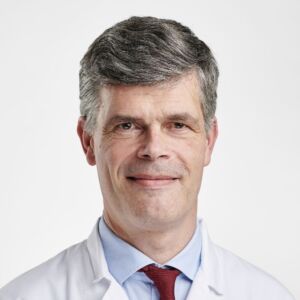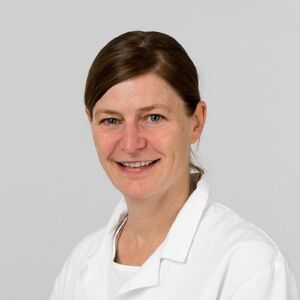Treatment of carcinoma of the esophagus (esophageal carcinoma)
Various procedures are available today for the treatment of esophageal cancer, which are used depending on the stage. Careful clarification by means of endoscopy, endoscopic ultrasound and imaging procedures (CT, PET, PET-CT) and a subsequent decision in the interdisciplinary tumor board regarding the individual further therapy is therefore of particular importance.
- Surgical removal of the tumor together with the associated lymph nodes is the standard treatment for malignant cancer of the oesophagus. Depending on the location of the tumor and also on certain fine tissue characteristics of the tissue, either part of the esophagus or the entire organ must be resected. As a rule, the stomach is used as a substitute; in exceptional cases, an interposition of the large or small intestine is also necessary. After a familiarization phase, the quality of life after these procedures is generally good; most patients can eat solid and liquid food without any problems.
- Early stages of esophageal cancer are treated either by local endoscopic therapy (EMR = endoscopic mucosal resection; ESD = endoscopic submucosal dissection) or by limited radical surgery (Merendino surgery).
- The far more common advanced carcinomas are now usually treated with a combination of preoperative radiochemotherapy (neoadjuvant therapy) and subsequent radical surgery. A number of studies have shown that this strategy leads to a significant improvement in the chances of recovery compared to surgical therapy alone without appropriate pre-treatment(The Lancet Oncology 2015).
Innovation in the treatment of esophageal cancer
Esophagectomy can lead to life-threatening complications. A new procedure minimizes the risk, as a new accompanying clinical study at the USZ shows.
Surgical technique for esophageal cancer
For many patients with carcinoma of the esophagus, radical surgical removal of the tumor together with the adjacent lymph nodes is the only realistic chance of recovery. How good this chance is ultimately depends on a number of individual parameters (size and response of the tumor to neoadjuvant therapy, number of lymph nodes affected by the tumor). Depending on these factors, the disease-specific 5-year survival rate varies between 25 % and over 90 %.
The surgical technique that we perform as a standard procedure was first described in 1946 by the English surgeon Ivor Lewis (British Journal of Surgery 1946) and provides for the removal of the esophagus together with the surrounding lymph nodes via a right-sided thoracic approach. The resulting defect is bridged again with the help of the stomach, which has been converted into a tube. The procedure has been continuously improved over the years and can now also be performed using minimally invasive approaches and, in suitable cases, even with a surgical robot. In specialized surgical departments, the complication rate of this operation is low and the postoperative quality of life reaches that of healthy people in around half of patients (Langenbeck’s Archives of Surgery 2013).
Radiotherapy for esophageal cancer
Radiotherapy is another treatment option. Radiation can shrink larger tumors and subsequently enable surgery or be used in combination with chemotherapy as the sole treatment option. Radiotherapy also alleviates the symptoms of esophageal cancer. Swallowing difficulties in particular improve significantly. Details on radiotherapy for esophageal cancer can be found here.
Brachytherapy for esophageal cancer
Brachytherapy (small-area irradiation, afterloading) is irradiation from the inside. To do this, the doctor inserts a thin tube into the esophagus and places a tiny radioactive source near the tumor. Radiation from the inside can shrink the tumor or at least slow down its growth. Surrounding tissue, on the other hand, remains largely unaffected by the radiation.
Chemotherapy for esophageal cancer
During chemotherapy, you receive cell growth-inhibiting drugs, so-called cytostatics. The active substances in cytostatic drugs block the growth of cancer cells. For large tumors, doctors sometimes combine radiotherapy and chemotherapy. This so-called radiochemotherapy is used to shrink the tumor before surgery (neoadjuvant therapy). Radiochemotherapy also alleviates the symptoms if surgery is not possible.
Laser therapy for esophageal cancer
If tumors prevent swallowing, the doctor can partially remove them during an esophagoscopy using laser therapy. During laser therapy, he vaporizes part of the tumor. The disadvantage of this treatment is that it only reaches the surface of the tumor and the cancer quickly grows back. This treatment must therefore be repeated at regular intervals.
Photodynamic therapy for esophageal cancer
Photodynamic therapy (PDT) is an alternative procedure. PDT is only used in the early stages of esophageal cancer. In photodynamic therapy, the doctor administers a drug that makes the body tissue extremely sensitive to light. Three days later, the doctor irradiates the tumor with laser light. PDT temporarily makes the skin more sensitive to the sun.
Percutaneous endoscopic gastrostomy for esophageal cancer
For palliative therapy, the doctor places a thin tube through the abdominal wall into the stomach. The feeding tube enables feeding without swallowing difficulties.
Aftercare and rehabilitation
Regular follow-up care is important after esophageal cancer surgery. Aftercare is symptom-oriented. During the follow-up examination, the doctor checks, for example, whether the cancer recurs after the operation (recurrence). Don’t be afraid to go to the doctor outside of the agreed appointments if you have symptoms such as swallowing difficulties.
Whether rehabilitation is sensible and possible after oesophageal cancer treatment depends on the individual case. There are special tumor aftercare clinics that offer inpatient rehabilitation after surgery. They are familiar with the needs of patients with esophageal cancer. Rehabilitation is adapted to individual needs. It includes, for example, medical, nursing, training and psychosocial measures. Specialized rehab clinics are also available for patients with alcohol problems and oesophageal cancer.

Certificate
Ask the professor
Our expert for esophageal tumors (esophagus), stomach surgery, endocrine surgery) answers the most frequently asked questions about endocrine surgery online.
To the website


